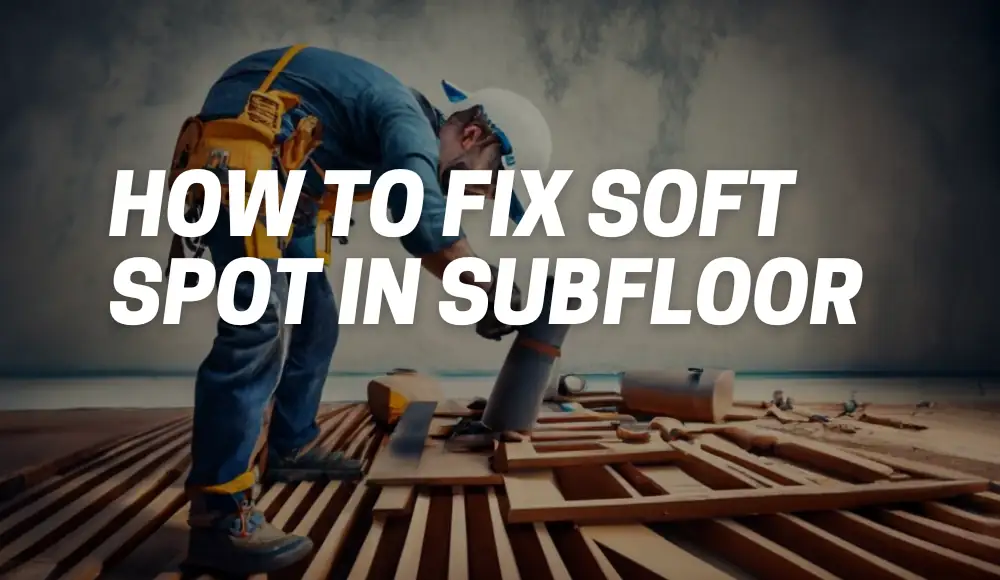Last updated on February 5th, 2025 at 08:23 am
Soft spots in a subfloor can be a homeowner’s nightmare. They’re like those hidden surprises that rear their ugly heads at the most inconvenient times. Whether you’ve just discovered one or you’ve been living with it for a while, this guide will help you tackle the issue. From understanding the causes to the tools you’ll need and the steps to take, we’ve got you covered.
What Causes Soft Spots in Floors?
Soft spots in a subfloor can be caused by a variety of factors. Understanding the root cause is essential for effective repair. Here are some common culprits:
- Water Damage: Perhaps the most common cause. Leaky pipes, flooding, or even spills that weren’t properly cleaned up can lead to soft spots over time.
- Termite Infestations: These tiny terrors can wreak havoc on your subfloor. Termites can eat away at wooden subfloors, leaving behind soft and weakened areas.
- Structural Problems: Sometimes, it’s not just the subfloor; it’s the entire structure. If your home has settling issues or weak supports, your subfloor may suffer.
- Poor Installation: If the subfloor was improperly installed in the first place, it may develop weak points over time.
- Excess Moisture: High humidity or poor ventilation can lead to excess moisture buildup in your subfloor, weakening it.
How Can I Identify Soft Spots in My Subfloor?
Identifying soft spots in your subfloor is the crucial first step in addressing the issue. Here’s how you can do it:
- Tapping Test: Walk around your home and tap the floor with a blunt object. A hollow sound or a noticeable bounce indicates a soft spot.
- Visual Inspection: Look for any visible signs of damage. This could be sagging areas or even visible mold and mildew growth, which can be a result of moisture-related issues.
- Bouncing Test: Stand on the suspected soft spot and bounce gently. If it gives way or feels spongy, you’ve likely found a problem area.
- Check for Uneven Flooring: Place a level on your floor. If it doesn’t sit flat, it’s a sign of an uneven subfloor.
Can You Fix an Uneven Subfloor?
Yes, you can fix an uneven subfloor, and that’s what we’ll delve into next.
What Tools Do I Need to Repair a Soft Spot in the Subfloor?
Repairing a soft spot in the subfloor requires specific tools and materials. Here’s what you’ll need:
- Circular Saw: To cut out damaged sections.
- Plywood or OSB: For patching.
- Screws: For securing the new subfloor to the joists.
- Hammer and Nails: For reinforcing the subfloor.
- Safety Equipment: Don’t forget gloves and goggles to protect yourself during the process.
Is it Possible to Fix a Soft Spot Without Replacing the Entire Subfloor?
Yes, it is possible to fix a soft spot without replacing the entire subfloor. One common method is called “sistering joists.” This involves adding additional joists alongside the weakened ones to provide extra support. You can then patch the subfloor on top of the reinforced joists.
How Do I Prepare the Subfloor for Repair?
To prepare your subfloor for repair, follow these steps:
- Remove the Damaged Flooring: Take up the damaged floor covering to expose the subfloor.
- Clean the Area: Remove any debris, nails, or staples that might be in the way.
- Assess the Extent of the Damage: Determine how large the soft spot is and whether there’s any structural damage to the joists.
How Do You Fix a Spongy Subfloor?
Fixing a spongy subfloor involves a series of steps:
Materials and Tools You’ll Need:
- Circular saw
- Pry bar
- Replacement subfloor material (plywood or OSB)
- Construction adhesive
- Screws
- Drill
- Level
- Carpenter’s square
- Screwdriver
- Safety goggles
- Ear protection
- Dust mask
Step 1: Identify the Affected Area Determine the location and extent of the spongy subfloor. This can often be done by gently pressing on the floor, looking for areas that flex or feel soft.
Step 2: Remove the Flooring
- If necessary, remove the flooring covering the affected area. This could be hardwood, laminate, carpet, or any other material.
- Use a pry bar or a similar tool to carefully lift and remove any baseboards or trim that might be in the way.
Step 3: Cut Out the Damaged Subfloor
- Use a circular saw to cut through the damaged subfloor material. Make straight cuts along the floor joists to ensure that you’re removing the full span of damaged subfloor.
- Remove the damaged subfloor sections carefully, exposing the joists.
Step 4: Check for and Address Structural Issues Inspect the floor joists and make sure they are in good condition. If any joists are damaged or rotten, they should be replaced or reinforced.
Step 5: Install the Replacement Subfloor
- Measure and cut a replacement piece of subfloor material (usually plywood or OSB) to fit the opening. Ensure that the edges align with the center of the floor joists.
- Apply construction adhesive to the top of the joists.
- Lay the replacement subfloor into place.
- Screw the subfloor down into the joists using screws long enough to penetrate through the subfloor and into the joists. Make sure to space the screws according to the manufacturer’s recommendations (typically around 6 inches apart along the edges and 8 inches apart in the field).
- Use a level and carpenter’s square to ensure that the replacement subfloor is level and square with the surrounding subfloor.
Step 6: Reinstall the Flooring If you removed flooring in Step 2, reinstall it over the repaired subfloor according to the manufacturer’s guidelines.
Step 7: Finish and Clean Up Replace any baseboards, trim, or molding that you removed. Clean up the work area, and dispose of any waste material properly.
Step 8: Allow the Adhesive to Cure Let the construction adhesive and any other materials used to secure the subfloor cure according to the manufacturer’s instructions. This might take a day or more.
Fixing a spongy subfloor can be a challenging DIY project, and if you’re uncertain about your skills, it’s a good idea to consult a professional contractor. A solid, well-secured subfloor is essential for the longevity of your flooring and the overall structural integrity of your home.
—
How to Fix a Soft Spot in Hardwood Floor
Repairing a soft spot in a hardwood floor is a bit more delicate but certainly doable. Follow these steps:
Materials and Tools You’ll Need:
- Circular saw
- Chisel or pry bar
- Replacement hardwood flooring
- Construction adhesive
- Screws
- Drill
- Floor-leveling compound
- Sandpaper
- Wood filler
- Finish (stain and sealant)
Step 1: Identify the Soft Spot Determine the extent of the damage by gently pressing down on the affected area. If the wood feels soft or spongy, it needs to be repaired.
Step 2: Remove the Damaged Boards
- Find the nearest floor joists to the soft spot. You can use a stud finder to locate them.
- Use a circular saw to cut through the damaged floorboards along the length of the joists.
- Carefully pry up and remove the damaged boards.
Step 3: Install Reinforcements If the soft spot was caused by structural issues, reinforce the floor by adding additional support, such as sistering joists, to prevent future problems.
Step 4: Replace the Subfloor
- Clean out any debris or damaged subfloor material to ensure a smooth, clean surface.
- Install a new piece of subfloor to replace the damaged area, making sure it’s level with the surrounding floor.
Step 5: Install New Hardwood Flooring
- Measure and cut the replacement hardwood flooring to fit the opening.
- Apply construction adhesive to the back of the new boards and press them into place.
- Secure the new boards to the subfloor by screwing them down into the joists. Be sure to countersink the screws slightly below the surface of the wood.
- Fill the screw holes with wood filler and sand the area until it’s smooth and level with the rest of the floor.
Step 6: Stain and Seal the Floor If the new boards don’t match the rest of the floor, you may need to stain them to achieve a consistent color. After staining, apply a clear sealant to protect the wood.
Step 7: Sand and Finish Sand the entire floor to ensure a smooth, even surface. Then apply a finish coat of your choice to protect and enhance the appearance of the floor.
Step 8: Allow to Dry Allow the finish to dry according to the manufacturer’s instructions before walking on the repaired area.
It’s essential to use appropriate safety equipment and take your time to ensure a quality repair job. If you’re uncertain about your DIY skills, consider consulting a professional flooring contractor.
What Type of Flooring Can Be Installed Over a Repaired Subfloor?
After repairing your subfloor, you might be wondering what kind of flooring you can install. The good news is that once your subfloor is solid, you have numerous options. You can go with hardwood, laminate, vinyl, carpet, or even tile, depending on your preferences.
How Long Does It Take to Fix a Soft Spot in the Subfloor?
The time required to fix a soft spot in your subfloor can vary based on several factors, including the size of the damaged area, your experience level, and the tools you have. On average, a moderately skilled DIYer can expect the job to take anywhere from a day to a few days, accounting for drying times for adhesives or patching materials.
Are There Any Safety Precautions I Should Take During the Repair Process?
Yes, safety should always be a priority. When repairing a soft spot in your subfloor, remember to:
- Wear Appropriate Safety Gear: Gloves and goggles are essential to protect yourself from dust, debris, and potential injury.
- Work in a Well-Ventilated Area: Proper ventilation is crucial when dealing with adhesives or chemicals.
- Use the Right Tools: Ensure that your tools are in good working order to avoid accidents.
When Should I Consider Hiring a Professional to Fix a Soft Spot in My Subfloor?
While many soft spot repairs can be DIY projects, some scenarios warrant professional assistance. Consider hiring an expert if:
- The damage is extensive and beyond your skill level.
- You’re unsure about the structural integrity of your subfloor.
- You lack the time, tools, or confidence to tackle the repair.
What Are Common Mistakes to Avoid When Fixing a Soft Spot in the Subfloor?
Avoiding common mistakes is crucial for a successful repair. Here are some pitfalls to steer clear of:
- Rushing the job without proper preparation and assessment.
- Neglecting to address the root cause, may lead to recurrence.
- Using subpar materials or tools, compromising the repair’s durability.
Can I Prevent Soft Spots in the Subfloor in the Future?
Preventing soft spots in your subfloor is possible with a few proactive measures:
- Regularly inspect for leaks and address them promptly.
- Keep humidity levels in check to prevent excess moisture.
- Ensure proper ventilation in your home.
- Invest in termite prevention measures.
How Do You Fix Moisture in a Subfloor?
Fixing moisture issues in your subfloor is essential to prevent future soft spots. This involves identifying the source of moisture, whether it’s a leak or poor ventilation, and addressing it. Additionally, consider using a moisture barrier on the subfloor to keep it dry.
Here are steps to address moisture in a subfloor:
Materials and Tools You’ll Need:
- Moisture meter
- Dehumidifier
- Fans
- Plastic sheeting (6-mil polyethylene)
- Tape
- Vapor barrier
- Replacement subfloor material (if necessary)
- Screwdriver
- Construction adhesive
- Screws
- Drill
- Safety goggles
- Dust mask
Step 1: Identify the Source of Moisture Determine the source of moisture in your subfloor. Common sources include leaks from plumbing, roof leaks, poor ventilation, or high humidity. Addressing the source is essential to prevent further moisture issues.
Step 2: Assess the Damage Use a moisture meter to measure the moisture content in the subfloor. This will help you understand the extent of the damage. In many cases, a subfloor with high moisture levels may need to be replaced.
Step 3: Remove Flooring If there’s moisture damage in your subfloor, you may need to remove the flooring to access and treat the subfloor properly. Remove any floor coverings, such as hardwood, laminate, carpet, or tile.
Step 4: Reduce Humidity If the moisture issue is due to high humidity, consider using a dehumidifier and fans to reduce the humidity levels in the room. This can help prevent further moisture buildup.
Step 5: Seal Crawl Spaces or Basements If your subfloor is over a crawl space or basement, make sure these areas are properly sealed and insulated to prevent moisture from rising into the subfloor.
Step 6: Install a Vapor Barrier If your subfloor is above a crawl space, consider installing a vapor barrier on the ground. This can help prevent moisture from reaching the subfloor. Secure the vapor barrier with tape and ensure it covers the entire area under the subfloor.
Step 7: Replace Moisture-Damaged Subfloor (if necessary) If the subfloor is significantly damaged due to moisture and cannot be salvaged, you may need to replace it. Follow these steps:
- Remove the damaged subfloor material, making sure to cut along the joists.
- Measure and cut a replacement piece of subfloor material (plywood or OSB) to fit the opening.
- Apply construction adhesive to the joists and secure the replacement subfloor material with screws, spaced according to the manufacturer’s recommendations.
- Level the subfloor and ensure it’s securely attached.
Step 8: Reinstall Flooring Reinstall your flooring material, following the manufacturer’s guidelines for installation.
Step 9: Regular Maintenance Regularly check the moisture levels in your subfloor to ensure that the issue doesn’t recur. Make sure that any leaks are promptly addressed, and maintain proper ventilation in the space.
If you’re unsure about your ability to address the issue effectively, it’s a good idea to consult a professional contractor or a moisture remediation specialist.
What Is the Subfloor Repair Cost?
The cost of subfloor repair can vary widely depending on the extent of damage and whether you choose to DIY or hire a professional. DIY repairs are more cost-effective, primarily involving the price of materials, which can range from $50 to $200 or more. Professional repairs can cost several hundred to over a thousand dollars.
In conclusion, fixing a soft spot in your subfloor is a manageable task with the right knowledge and tools. By understanding the causes, identifying soft spots, and following the necessary steps for repair, you can restore the stability and safety of your home. Whether you choose to DIY or hire a professional, addressing this issue promptly will ensure the longevity of your flooring and peace of mind. So, roll up your sleeves, put on those safety goggles, and get ready to give your subfloor the TLC it deserves!
For more in-depth information on subfloor repair and related topics, consider referring to authoritative sources such as This Old House.


